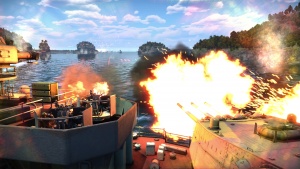Difference between revisions of "V-11 (37 mm)"
m (Put in the description and history that somehow didn't transfer over from my original writing of the page.) (Tag: Visual edit) |
|||
| Line 1: | Line 1: | ||
== Description == | == Description == | ||
| − | + | ''Write an introduction to the article in 2-3 small paragraphs. Briefly tell us about the history of the development and combat using the weaponry and also about its features. Compile a list of air, ground, or naval vehicles that feature this weapon system in the game.'' | |
| − | |||
| − | |||
=== Vehicles equipped with this weapon === | === Vehicles equipped with this weapon === | ||
| Line 53: | Line 51: | ||
== History == | == History == | ||
| − | + | ''Examine the history of the creation and combat usage of the weapon in more detail than in the introduction. If the historical reference turns out to be too long, take it to a separate article, taking a link to the article about the weapon and adding a block "/History" (example: <nowiki>https://wiki.warthunder.com/(Weapon-name)/History</nowiki>) and add a link to it here using the <code>main</code> template. Be sure to reference text and sources by using <code><nowiki><ref></ref></nowiki></code>, as well as adding them at the end of the article with <code><nowiki><references /></nowiki></code>.'' | |
| − | |||
| − | |||
| − | |||
| − | |||
| − | |||
| − | |||
| − | |||
| − | |||
| − | |||
| − | |||
| − | |||
| − | |||
| − | |||
| − | |||
| − | |||
| − | |||
| − | |||
| − | |||
== Media == | == Media == | ||
Revision as of 09:26, 5 August 2021
Contents
Description
Write an introduction to the article in 2-3 small paragraphs. Briefly tell us about the history of the development and combat using the weaponry and also about its features. Compile a list of air, ground, or naval vehicles that feature this weapon system in the game.
Vehicles equipped with this weapon
General info
This gun fires quickly for its size, with a reload time of 0.43 seconds stock, 0.33 seconds with an expert crew. The mount is fully traversing, limited only by objects in its way such as other guns or parts of the ship. Vertical guidance is -5°/+89° which gives it the ability to fire anywhere it pleases.
Available ammunition
On the coastal ships Yenot and Rosomacha, you have a choice between Universal (50/50), HE (5 HEF-T/1 AP-T), or AP (1 HEF-T/5 AP-T).
Universal is very useful as it is able to damage both aircraft and lightly armoured ships severely. With how fast the gun can fire, only half of the belt being HE is not an issue against aircraft, and the same holds true for the AP rounds against other vessels.
Comparison with analogues
Compared to the earlier 45 mm/46 21-K, the V-11 fires 5 times faster while not sacrificing too much explosive mass.
The 40 mm Bofors guns found on many American and British vessels have almost identical performance to the V-11.
The 37 mm guns found on German ships have far lower fire rates, while the 37s found on Italian ships are either better (Breda mod.38/mod.39) or far worse (Breda mod.32).
The Japanese have no direct counterpart, the closest being their trusty 25 mm mounts which have a fire rate 5 times slower.
Usage in battles
This gun is best used as it was designed: to crush enemy aircraft with its devastating fire rate and high-explosive shells as well as smother enemy lightly-armoured vessels with its armour-piercing rounds. This mount does not have the best horizontal traverse rate, so it is advisable to take control of the turrets and rotate them towards the target you want them to engage before they come into range and you turn it over to the AI.
Pros and cons
Pros:
- High fire rate, can devastate enemy aircraft/light vessels easily.
- Near-perfect -5°/+89° vertical guidance, aircraft cannot avoid this weapon by attacking from directly overhead.
- Far better effective range compared to the 20 mm cannons found on earlier ships.
Cons:
- Somewhat slow traverse rate, skilled pilots can easily evade AI gunners.
- Despite having a mount shield visual, the armour isn't modeled so this mount gets easily knocked out.
- On cruisers you cannot select different ammo belts like you can on the coastal ships equipped with this weapon.
History
Examine the history of the creation and combat usage of the weapon in more detail than in the introduction. If the historical reference turns out to be too long, take it to a separate article, taking a link to the article about the weapon and adding a block "/History" (example: https://wiki.warthunder.com/(Weapon-name)/History) and add a link to it here using the main template. Be sure to reference text and sources by using <ref></ref>, as well as adding them at the end of the article with <references />.
Media
See also
- 70-K (37 mm) - Single barrel variant
External links




